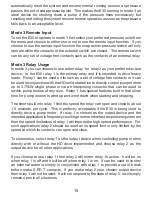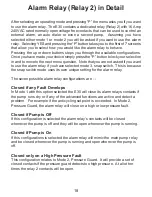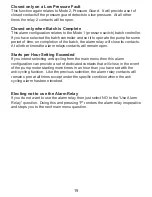
4
Programming the E30
The E30 is fully programmable. It accepts input via 4 push buttons. The buttons
are marked (P) for programming, Up and Down for data entry and a reset button
(R). Pressing the (P) button during normal operation stops the pump and allows
entry to the E30’s menu, provided the pressure switch is unlocked. Subsequent
pressing of the (P) button steps you through the menu from one option to the next.
Each option can be adjusted using the up and down buttons.
Pressing the (P) button stores the settings you make into the E30’s memory and
steps you to the next option. When you reach the end of the options list the menu
asks you to press the (R) reset button to confirm your settings and to resume
normal running. You can automatically save any changes you have made and
exit out of the menu at any time by simply pressing the reset button. The settings
you make are non-volatile and are recorded into the E30’s memory . Your settings
will not be lost if the pressure switch is switched off for extended periods. When
power resumes the E30 is switched back on and the E30 will automatically boot
up and resume running using the settings you recorded in its memory.
The Three Operating Modes
The E30 can be set to operate in one of three fundamental modes. An initial
choice must be made as to how you want to control the pump. Once you have
made your choice the E30’s menu will ask you a series of questions that relate to
the specific mode you have chosen.
Mode 1 Pressure Switch
In mode 1 the E30 operates as a differential loss of prime pressure switch. Mode
1 provides you with a start-up timer to allow time for the pump to start and for the
system pressure to climb above whatever trip pressure you may enter. A run-on
timer is also available so the E30 can ignore short term dips in pressure without
tripping out on low pressure. In addition, delayed restarting is available as is anti-
cycling, batch running and automatic run dry restarting.
In mode 1 the E30 can be used to control a pump and to give it dry run protection
in the event of loss of pressure. Conventional pressure switches will continue to
run a pump if pressure is lost. This invariably damages the pump. In addition to







































